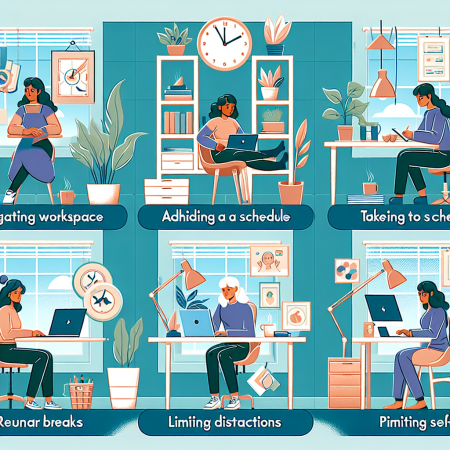5 Tips for Setting Boundaries When Working From Home
Table of Contents
- Creating a Dedicated Workspace
- Communicating Your Availability
- Setting Specific Work Hours
- Taking Regular Breaks
Creating a Dedicated Workspace
One of the most crucial aspects of working from home is establishing a dedicated workspace. Trust me, it’s a game-changer. A dedicated area can help you differentiate between your work life and personal life. It’s like flipping a switch in your brain, helping you to ‘turn on’ when you’re in your workspace and ‘turn off’ when you’re out of it.
Firstly, select a spot in your home that’s solely for work. It doesn’t have to be a full-blown home office. A corner of your living room, a nook in your bedroom, or even a well-setup dining table can work wonders. The key is consistency. When you associate a specific area with work, your mind gets the memo that it’s time to get serious.
Next, make sure your workspace is comfortable and free of distractions. Comfy chair? Check. A table at the right height? Double-check. Good lighting and a bit of greenery to keep the vibe fresh? Absolutely. This comfort will make it easier for you to spend long hours working without strain or stress, thus boosting your productivity.
Communicating Your Availability
Communication is fundamental when you’re working from home. If you’re in constant communication with your team, clients, or even family members, it can make the whole process much smoother. Let’s dive into how to communicate your availability effectively.
Firstly, using calendar tools like Google Calendar or Outlook can be a lifesaver. Share your work hours and when you’re available for meetings. This way, there’s no confusion about when someone can reach out to you. It’s all clear and in the open.
Secondly, don’t shy away from setting boundaries with your family or housemates. It’s okay to tell them that you’re not available between certain hours. Lay it out like, “Hey folks, from 9 AM to 5 PM, I’m in work mode.” This can reduce unnecessary interruptions and keep your focus intact.
Lastly, keep communication channels open but with limits. You don’t have to respond to emails or messages immediately. Allocate specific times during the day to check and respond to messages. This ensures that you’re not constantly distracted but are still within reach when necessary.
Setting Specific Work Hours
Establishing specific work hours is another critical aspect of working from home. It provides structure to your day and helps separate work from personal time. I’ve found that having a consistent routine makes a world of difference.
First off, determine your peak productivity hours. Are you a morning person or a night owl? Align your work hours with when you’re most productive. This will help you get more done in less time.
Once you’ve nailed down your work hours, stick to them religiously. Consistency helps train your mind and body to know when it’s time to work and when it’s time to relax. It creates a rhythm that can improve your overall well-being.
Finally, make sure to log off and shut down once your work hours are over. Turn off your computer, close your workspace, and shift into personal time. This ritual helps signal to your brain that the workday is done, helping you unwind and recharge for the next day.
Taking Regular Breaks
Breaks are not just nice to have; they’re essential for maintaining productivity and mental health. I can’t emphasize enough how important it is to take breaks while working from home. It’s easy to get caught up in tasks and forget to step away, but trust me, those breaks matter.
Start by scheduling your breaks. You can use methods like the Pomodoro Technique, where you work for 25 minutes and then take a 5-minute break. After four cycles, take a longer break of 15-30 minutes. This not only boosts productivity but also keeps you fresh and attentive.
During your breaks, step away from your work area. Go for a short walk, do some stretches, or grab a healthy snack. The idea is to give your mind a breather and your body some movement. It’s a great way to reset and come back to your tasks with renewed energy.
Remember to take a proper lunch break as well. This is your time to nourish your body and take a substantial break from your work. Avoid eating at your desk. Treat your lunch break as a mini escape from work duties, and you’ll find it easier to dive back into your tasks afterward.
Frequently Asked Questions (FAQ)
1. Why is it important to have a dedicated workspace when working from home?
A dedicated workspace helps you mentally distinguish between work time and personal time, boosting your productivity and helping you to maintain a work-life balance.
2. How can I effectively communicate my availability while working from home?
Utilizing calendar tools to share your work hours, setting boundaries with family, and allocating specific times for checking messages can help communicate your availability clearly and effectively.
3. What are the benefits of setting specific work hours?
Setting specific work hours helps create a structured routine, increases productivity by aligning with your peak times, and ensures a clear separation between work and personal life.
4. Why are regular breaks important when working from home?
Regular breaks prevent burnout, keep your mind fresh, and help maintain overall productivity. Techniques such as the Pomodoro method can be very effective.
Related Content
- How to Create a Scalable Coaching Business Online
- The Ultimate 2025 Guide: 7 Effective Tips on How to Advertise on Yahoo for Beginners
- Use minimalistic design elements to highlight key product attributes without distractions
- How to Create Engaging Pop-Ups
- Build long-term brand advocates by consistently exceeding customer expectations

